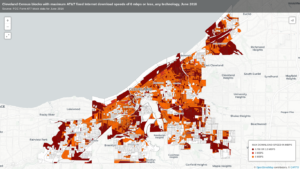A new article in Pacific Standard points out that the same slow inner-city Internet speeds that recently became an issue for AT&T’s low income discount program could also create a real problem for the Federal Communications Commission’s Lifeline broadband initiative.
In “The Looming Lifeline Internet Subsidy Crisis”, PS‘s Rick Paulus quotes NDIA’s Angela Siefer:
When the FCC announced a tweak to the country’s $9.25 a month Lifeline subsidy to allow it to be used for home Internet service as well as telephone service, they wrote in the same sort of minimum requirements for download speeds. But this time, the minimum speed is 10 Mbps.
“What will happen is that an eligible person will assume they can get Lifeline broadband, and then find they cannot get the subsidized service because AT&T does not offer 10 megs of service at their address,” Siefer says. “Many low-income areas don’t get 10 megs.”
It’s a problem that could reach beyond AT&T, one of many ISPs expected to participate in the Lifeline program. Comcast, CenturyLink, Time Warner, Cox, and every other ISP will be needed to help accomplish the program’s goal of bringing affordable Internet to low-income residents. But the presumed exploitation of this loophole on a national scale may make the entire subsidy essentially meaningless.
“None of the providers have told us what their Lifeline offerings are going to be,” Siefer says. “But it won’t be as useful as we thought it was, because they have such slow speeds in poor neighborhoods.”
Paulus’ use of the word “loophole” here is questionable. Lifeline telephone providers and other ISPs are not required to start offering Lifeline broadband plans, and the FCC certainly knew that its 10 mbps minimum speed for wired (not wireless) Lifeline plans would affect companies’ decisions whether to do so.
But did the FCC Commissioners have any idea that the download speeds offered by telcos like AT&T remain so slow in so many urban neighborhoods, where millions of Lifeline-eligible consumers live, when they adopted the 10 mbps threshold? Judging from the agreement they reached with AT&T in the case of the Access program, it doesn’t seem likely.
Working with the FCC’s newly released Form 477 block data for December 2015, NDIA has found that AT&T’s maximum advertised DSL speed is below 10 mbps for about 33% of Census blocks in the city of Cleveland, and for 35% of blocks in the city of Detroit. Here’s a map showing the third of all Census blocks in Cleveland where households can’t buy 10 mbps AT&T Internet (click on the image to see it full size).
(For a deeper discussion of the underlying issues, take a look at “Cleveland and the Return of Broadband Redlining” by Harold Feld of Public Knowledge.)

